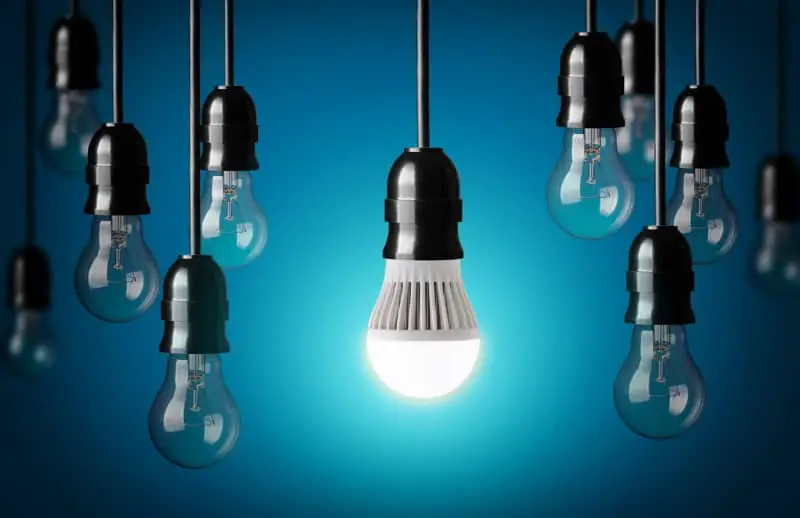LED (light emitting diode) lights have become popular in most homes due to their energy efficiency. They’re long-lasting, consume less energy, and are always brighter than other light bulbs. There are concerns, however, about LED lights and exposure to EMF radiation. You may wonder, do LED lights emit EMF?
LED lights do emit both electric and magnetic field (EMF) radiation. Though LED lights consume a small amount of electricity, they sometimes emit dirty electricity which is harmful to your health and that of your family.
Since LED lights transmit light through short waves, they do emit blue light which generates high levels of radiation that is harmful to your health. The EMF radiation in LEDs is in the form of radio waves.
Each LED light bulb has a diode that acts as a good conductor of energy and determines the direction of the flow of energy so as to light up the LED bulb. As a result, LEDs use little energy compared to other types of bulbs. Normal light bulbs consume electricity at a standard rate of 40 to 50 HZ. This makes LED lights more energy efficient, hence their increased popularity in homes.
How LED Lights Work
With the advancement of technology, more efficient LED bulbs are designed to replace traditional bulbs. These LED bulbs are more bright and cost-effective. The only difference between LED bulbs and the traditional bulbs is how light is produced.
LEDs use a semiconductor material that generates lights as the current passes through the semiconductor material, while traditional incandescent bulbs emit light when current passes through a thin wire filament.
Other energy-saving bulbs pass current via mercury vapour so as to emit UV light. The phosphor coating inside the bulb absorbs the UV light.
Though LED light bulbs consume less electricity, the same amount of electricity flows through the wiring system in your home. The bulb only uses a small amount of flowing electricity and the remainder is sent back to the wiring system. This causes dirty electricity.
The internal switching regulator inside the bulbs helps convert from AC to DC. If the bulb has a switched-mode power supply, it reduces the voltage flowing through the bulb, thereby generating dirty electricity.
The lighting process also adds an additional frequency to your wiring system that increases the flow of dirty electricity. Dirty electricity emits high levels of extra low frequency (ELF) radiation, which is more harmful to those who are hypersensitive to electromagnetic radiation.
You can read more about the dirty electricity produced by different LED lights here.
Impact of LED Lights on Your Health
Continuous exposure to the blue and violet lights emitted by LEDs can affect your sleep cycle. Some people may experience mild headache, itchiness, and redness in the eyes. According to the 2016 American Medical Association (AMA) report, exposure of your retina and lens to blue lights for a long period leads to damage of the retina. It can also lead to melatonin suppression.
High exposure to LED lights, even for a short period, may result in changes of the retina. Although your lens and cornea have ultraviolet light-blocking capability as you age, continuous exposure can cause permanent damage to your retina.
Sometimes when there is a high-frequency supply of electricity, you may notice flickering of the LED lights. This flickering can affect you if you’re sensitive to EMF radiation.
As the LED lights flicker and dim, they can cause headaches. Flickering and dimming of the lights disrupts the normal movement of your eyes, and this may force your brain to work extra hard to control your eye movement, thus causing headaches.
There are studies that link ELF-EMF radiation to leukemia in children. High levels of dirty electricity around your home increases the risk of childhood leukemia.
The blue peaks from the LED light emit a lot of radiation. Experts are now recommending blocking the blue peaks in the range of 415 to 455 nm (nanometer) spectrum. Blue lights in the range of 400 to 460 nm have high levels of radiation that damages your eyes. Choosing lights in the range of 470 to 490 nm can help reduce the impact the lights have on your eyes.
Ways to Reduce Exposure to High EMF Levels
Reducing your exposure to EMF radiation is one of the best ways to reduce the health complications associated with it.
There are various energy efficient bulbs that require less electricity and generate low EMF radiation. For example, you can use incandescent light bulbs instead of using LED bulbs or smart bulbs. Some of the LED bulbs are smart bulbs which come with Wi-Fi or Bluetooth tools.
These LED-based bulbs not only produce dirty electricity but also emit ELF-EMF radiation. Those with Bluetooth signals emit dangerous radio frequency (RF) radiation.
If you have to use the LED-based bulbs, always ensure they’re kept away from your nightstand or anyplace that you routinely sit.
You should also ensure the blue peaks from the LED bulb is covered to reduce the amount of radiation being emitted by the blue peaks.
If the LED lights are in the bedroom and living area, ensure you also have incandescent bulbs in place. If you stay in the room for a long period, switch off the LED light and turn on the incandescent bulbs.
If you are in an open office setup with LED or fluorescent lights installed, you should try to step outside several times a day to give your body a break from the blue lights and dirty electricity produced by the LED lights.
If you’re in your own office, you can replace the LED bulbs with incandescent bulbs or turn off the LED lights to minimize your exposure. Make sure to seek permission if you need it before replacing the bulbs. Alternatively, you can open the blinds and windows and rely on natural light during bright days and switch off all the lights. This not only reduces EMF exposure, but the sunlight also acts as a great way to boost your mental health.
Watch this video to know the various ways you can protect yourself from blue lights:
Incandescent Bulbs
These are the most common types of light bulbs with low EMF. These bulbs use the set wiring standards for homes and they generate little or no dirty electricity. These types of bulbs are inexpensive and they’re very easy to set up.
Incandescent bulbs produce warm light and can be of great help to those people having issues with blue light from LED bulbs. The incandescent lights don’t affect your melatonin levels (a hormone that affects your sleep).
The Best Low EMF Bulbs
The best LED light bulbs are the ones that offer you consistently bright light and are more energy efficient. There are different brands of light bulbs on the market and the most expensive one may not always be the best.
Therefore, when buying LED lights you shouldn’t focus on the price alone. There are other factors you need to look at and compare them to your lighting needs before making your final buy decisions.
Factors to Consider When Buying Light Bulbs
1. Shape and Material
Bulbs come in a variety of shapes, sizes and have different bases depending on how they’re screwed into the fixture. These bulbs can also be made from plastic or glass.
Bulbs made of plastic are ideal for high wattage power. It’s upon you to choose the best shape and material based on your needs. You should also go for what is affordable for you.
2. Brightness level
Bulbs which have 60 W power are brighter than those labeled 40 W. 40 W bulbs are ideal for bedroom areas because their soft glow makes the environment feel more relaxed.
LED brightness is always measured in lumens though people use watts to describe the brightness.
All light bulb brands are required to label the bulb lumens (the amount of light the bulb puts out) and the amount of energy it uses in watts. For example,
40 W is equivalent to 450 lumens while 60 W is equivalent to 800 lumens.
3. Color Temperatures
Each bulb has a range of color temperatures measured in Kelvin (K). There are two types: the cooler light temperatures and warmer light temperatures.
Cooler light temperatures are in the range of 3,600 to 5,000 K while warmer temperatures range from 2,700 to 3,500 K.
In almost all brands, the 2,700 K color temperature is known as the “soft-white” while 3,500 K is described as the “bright-white”. A 5,000 K color temperature indicates “daylight”.
Cooler light bulbs are ideal for offices, kitchens, bathrooms or even your garage. Warmer light bulbs are mostly preferred for a bedroom or a sitting room.
4. Color Rendering Value (CRI) and R9 Values
CRI is used to measure color accuracy. LED bulbs have a standard CRI value of 80 while incandescent bulbs have a CRI of 100. LED bulbs should accurately render the CRI colors and the higher the value, the better. Some of the bulbs also indicate the R9 values to show the bulb’s red tones.
5. Dimmability
Choosing dimmable light bulbs will give you the opportunity to customize lighting based on your current mood or need. LED bulbs are long-lasting with some rated to work up to 10,000 hours.
Therefore, choosing dimmable bulbs will be of great importance especially if you upgrade the lamp, change the fixture or move.
6. Compatibility
Not every LED bulb can work with enclosed fixtures. There are some which can only be used indoors while others with weather ratings can be used both indoors and outdoors.
7. Price and Warranty
LED bulbs are cost-effective compared to other types of light bulbs. Different LED bulbs have different prices, and you can choose which is affordable to you.
The bulbs are designed to function for years continuously. Most of them only fade or lose their color as they age. Most come with a warranty.
Review of the Best LED Light Bulbs on the Market
1. Cree Soft White LED bulb
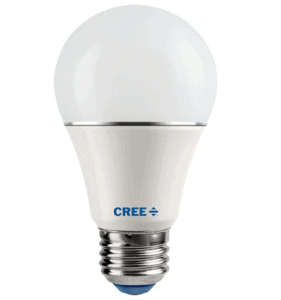
This is one of the most popular and safest LED light bulbs on the market. The Cree LED light bulb has a unique design and it makes your home look stunning and beautiful. The bulb blends well with your house décor making your home look more vibrant.
The soft white and daylight LED bulbs perform equally and are more efficient compared to other brands. Cree bulbs dim up to zero point and it doesn’t flicker or buzz when it is on.
The bulb uses only 9.5 W, saving you on energy bills and it is very cost-effective. The LED light colors are very good. The bulb has a color scheme that is higher than the average color rendering index (CRI-85).
The bulb is fully dimmable and because it doesn’t have any noticeable buzz, it gives you comfortable living experience. The Cree 60 W bulb can do well with in-wall dimmers and can provide you with service for up to 22 years.
Pros
- Provides you with perfect colors
- Has dimming capability
- Safer compared to other types
- 4 pack at affordable prices
- 22-year guarantee
Cons
- Not for use in enclosed fixtures
2. Philips A19 LED Bulb
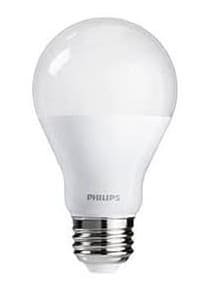
Philips manufactures both A19 warm glow and soft white versions which are great for home lighting.
The Philips 60 W LED bulb provides you with a warm glow and is suitable for bedroom use. The warm glow bulb looks more beautiful and it increases the color temperature of the bulb as it dims out. In the process, the bulb can lose its color fidelity.
The Philips 60 W dimmable LED bulb is suitable for daylight with a color temperature of 5,000 K. The bulb is highly customizable just like Cree 60 W bulbs. The soft light bulb works by emulating a luminous bulb.
The warm glow bulb emulates the feeling of a glowing light and this makes it ideal for a bedroom setup or night use. They have smooth dimming and are flicker free and can work with any dimmer switch.
The bulbs can fit in a medium-sized base of E26 but they’re not compatible with Philips Hue bulbs.
Pros
- Warm glow is ideal for night use
- Provides you with a dimmable LED light
- It has a soft light and a warm glow light
Cons
- Loss of color accuracy
- Slightly higher prices
3. Sylvania A19 60W LED Bulb
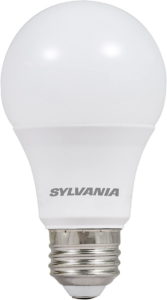
The 24 pack Sylvania LED bulbs are energy-efficient 60 W incandescent bulbs. Each of the bulbs uses 8.5 W of energy with a brightness of 800 lumens. They consume less energy, helping you save on energy bills and they act as a replacement to traditional incandescent bulbs.
The bulbs use a color temperature of 2,7000 K to generate a soft white color. This makes them ideal for use in your living area and dining room.
Pros
- Long-lasting bulbs
- Energy efficient
- No UV or IR radiation
- Environmentally safe
Cons
- Not dimmable
Soraa Radiant LED Bulb
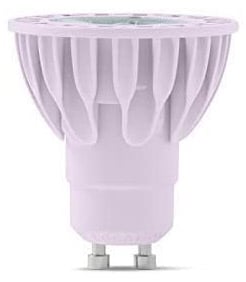
Most LED bulbs produce a color temperature with a yellowish tinge to pure white, while the red surfaces appear to be washed out. This is known as color gap. Soraa Radiant LED bulbs do not have the same effects and they always have accurate color temperatures. They also enhance the colors of your furniture and décor.
Pros
- Dimmable bulb light
- Colors on the surfaces are more vibrant
- No buzzing from the light
- No headaches
Cons
- Expensive
- With time the bulb fades
Bioluz LED Bulb

Bioluz (10 pack) is a dimmable 50 W Halogen LED replacement light with a color temperature of 3,000 K. It is one of Amazon’s fastest selling and highly rated MR16 series bulbs.
The case is made of aluminum material to enable the dissipation of heat and extend the bulb’s life. The 50 W dimmable light only uses 7 watts of power, thus saving you on electricity bills. The soft white version has a brightness equivalent to that of halogen bulbs.
The warm white version is brighter and has a color temperature of 27,000 K. Its brightness can be compared to incandescent lights.
Pros
- Environmentally friendly and safer to use
- Energy efficient bulbs
- Affordable
- Shatter and shock resistant
- 5 year warranty
Cons
- Some people report a short lifetime for the bulb.
Summary
EMF exposure has become a growing concern to a lot of individuals, not only at home but also in an office. Light bulbs are widely used both at home and in the office. You can choose from different types of LED light bulbs in the market.
LED light bulbs emit high levels of EMF radiation. They produce dirty electricity which is very harmful to your health.
If you have electromagnetic sensitivity, you should avoid using LED lights as they emit high levels of EMF radiation.
Lowering EMF radiation exposure is a great way to protect yourself and your family. If you are in an office environment, there is little you can do to control exposure since you may not be able to control lighting. You can suggest shifting to safer bulbs or natural lighting. Alternatively, you can bring in your own light fixtures if your office allows it.
Switching to incandescent bulbs will lower your EMF radiation exposure from the dirty electricity and blue light of LED bulbs.
Natural light is a great way to reduce EMF exposure during the day. You should consider turning off all the lights and open the curtains to allow sunlight inside your house or office. If the lights are not needed, they should always be turned off.


